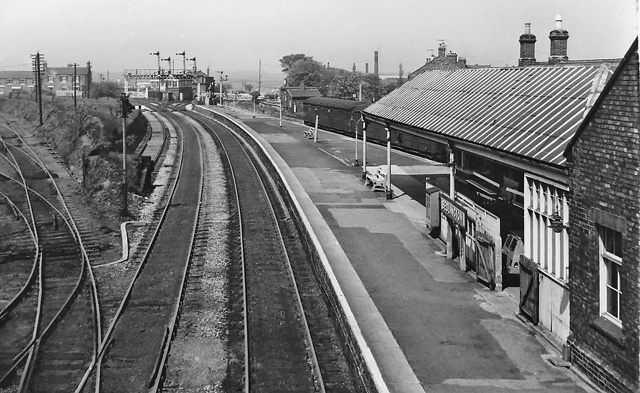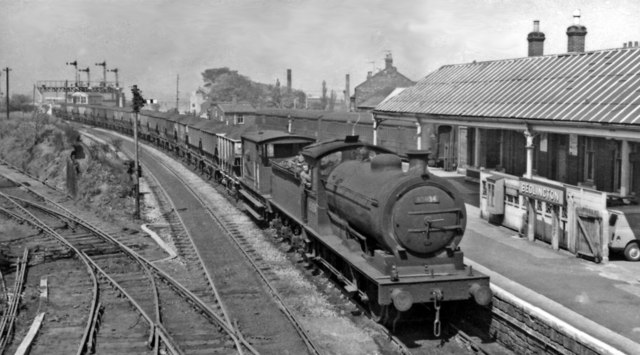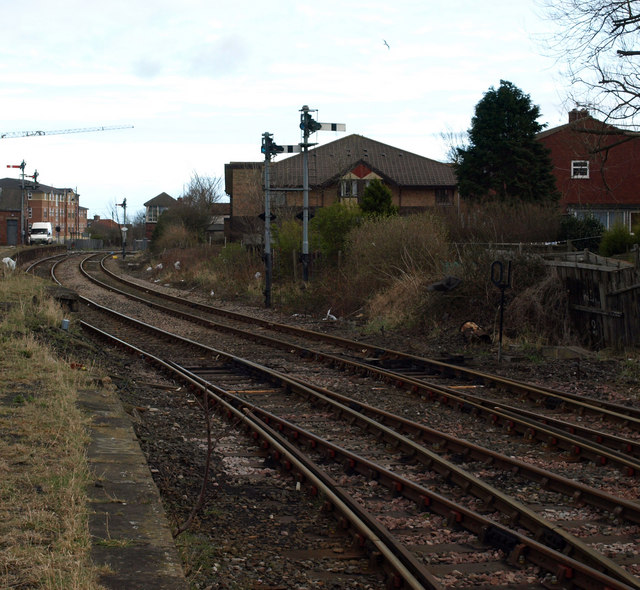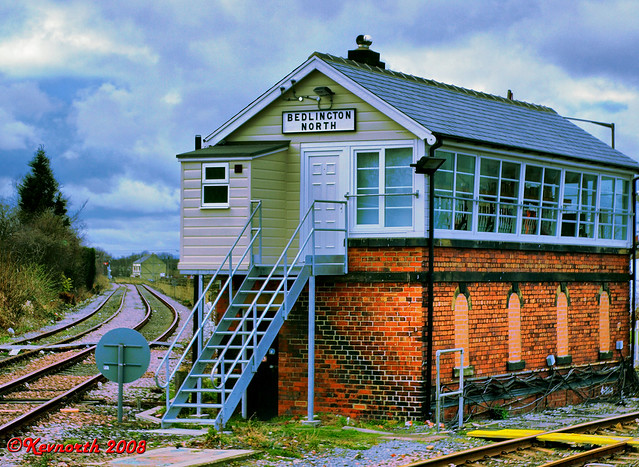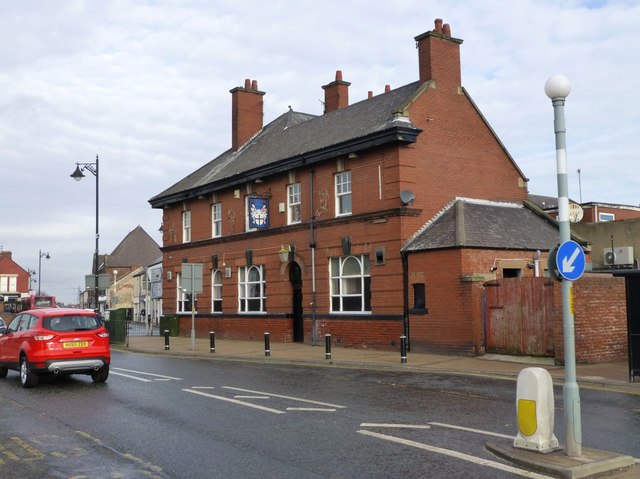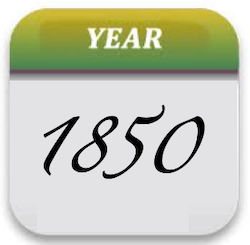Topics > Northumberland > Bedlington Station > Bedlington Railway Station (1850-1964)
Bedlington Railway Station (1850-1964)
Bedlington railway station was a railway station that served the town of Bedlington, Northumberland, England from 1850 to 1964 on the Blyth and Tyne Railway. The station was closed by British Railways in 1964, but it has been the subject of a reopening campaign since at least the 1990s.
History
The station was opened on 3 August 1850 by the Blyth and Tyne Railway. The station was situated on the north side of the level crossing on Station Road, west of the junction with Palace Road. Nearby was Bedlington Colliery. In 1911, NER statistics showed that a population of 14,755 had served the station in that year. In the interwar years, residential development grew in the vicinity of the station, thus the number of users who used it grew. The station closed to both passengers and goods traffic on 2 November 1964.
Reopening proposals
There have been proposals to reintroduce passenger services to part of the former Blyth and Tyne Railway system since the 1990s; Denis Murphy, the then Labour MP for Wansbeck, expressed support in the House of Commons in an adjournment debate in April 1999 and again in a debate in January 2007. The Railway Development Society (renamed Railfuture in 2000) also endorsed the proposal in 1998.
Later, in 2009, the Association of Train Operating Companies published a £34 million proposal to restore passenger services from to .
In the early 2010s, Northumberland County Council (NCC) became interested in the reintroduction of passenger services onto remaining freight-only sections of the network. In June 2013 NCC commissioned Network Rail to complete a GRIP 1 study to examine the best options for the scheme. The GRIP 1 study was received by NCC in March 2014 and in June 2015 they initiated a more detailed GRIP 2 Feasibility Study at a cost of £850,000.
The GRIP 2 study, which NCC received in October 2016, confirmed that the reintroduction of a frequent seven-day a week passenger service between Newcastle, Ashington and possibly a new terminus to the east, at , was feasible and could provide economic benefits of £70 million with more than 380,000 people using the line each year by 2034. At the time it was suggested that, subject to funding being raised for the £191 million scheme, detailed design work could begin in October 2018 with construction commencing four months later and the first passenger services introduced in 2021 though by October 2018 such works were yet to begin.
After receiving the GRIP 2 study, NCC initially announced that they were preceding with a GRIP 3 Study from Network Rail but such a report was not commissioned at the time. Despite a change in the political leadership of Northumberland County Council following the 2017 local elections the authority continued to work towards the reintroduction of a passenger service onto the line, encouraged by the Department for Transport's November 2017 report, A Strategic Vision for Rail, which named the line as a possible candidate for a future reintroduction of passenger services. Consequentially, NCC commissioned a further interim study in November 2017 (dubbed GRIP 2B) to determine whether high costs and long timescales identified in the GRIP 2 Study could be reduced by reducing the initial scope of the project but the report failed to deliver on this.
The county council has, however, continued to develop the project, announcing an additional £3.46 million in funding for a further business case and detailed design study (equivalent to GRIP 3) to be completed by the end of 2019. However, the revised proposals, released in July 2019, are reduced in scope from the plan considered in the 2016 GRIP 2 study and propose 4-phase project to reduce the initial cost of the scheme. Even so, under Phase 1 alone (at a cost of £90 million), it is envisaged that Bedlington station will be reopened as the penultimate stop for passenger trains on the Newcastle to Ashington Northumberland Line; this could occur as early as 2022. Later phases would see additional stations, as well as line-speed and capacity improvements, elsewhere on the line.
The North East Joint Transport Committee's bid for £377 million of funding from the UK Government's £1.28 billion Transfroming Cities Fund, submitted on 20 June 2019, includes £99 million to fund the reintroduction of passenger services between Newcastle and Ashington, while further work is ongoing to secure additional public and private investment for the project.
Visit the page: Bedlington railway station for references and further details. You can contribute to this article on Wikipedia.
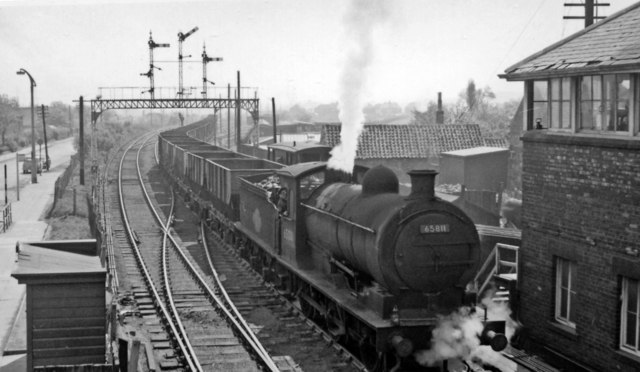
from Geograph (geograph)
Down empties train approaching Bedlington Station
Pinned by Simon Cotterill
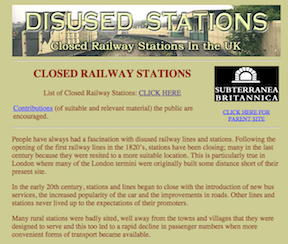
from http://disused-stations.org.u…
Bedlington Station
- "....The station was situated inconveniently about a mile north-east of the town, in the village of Sleekburn and close to Bedlington Colliery and several terraces of miners’ cottages. NER statistics …
Added by
Peter Smith


from Geograph (geograph)
Down empties train approaching Bedlington Station
Pinned by Simon Cotterill

from http://disused-stations.org.u…
Bedlington Station
- "....The station was situated inconveniently about a mile north-east of the town, in the village of Sleekburn and close to Bedlington Colliery and several terraces of miners’ cottages. NER statistics …
Added by
Peter Smith
